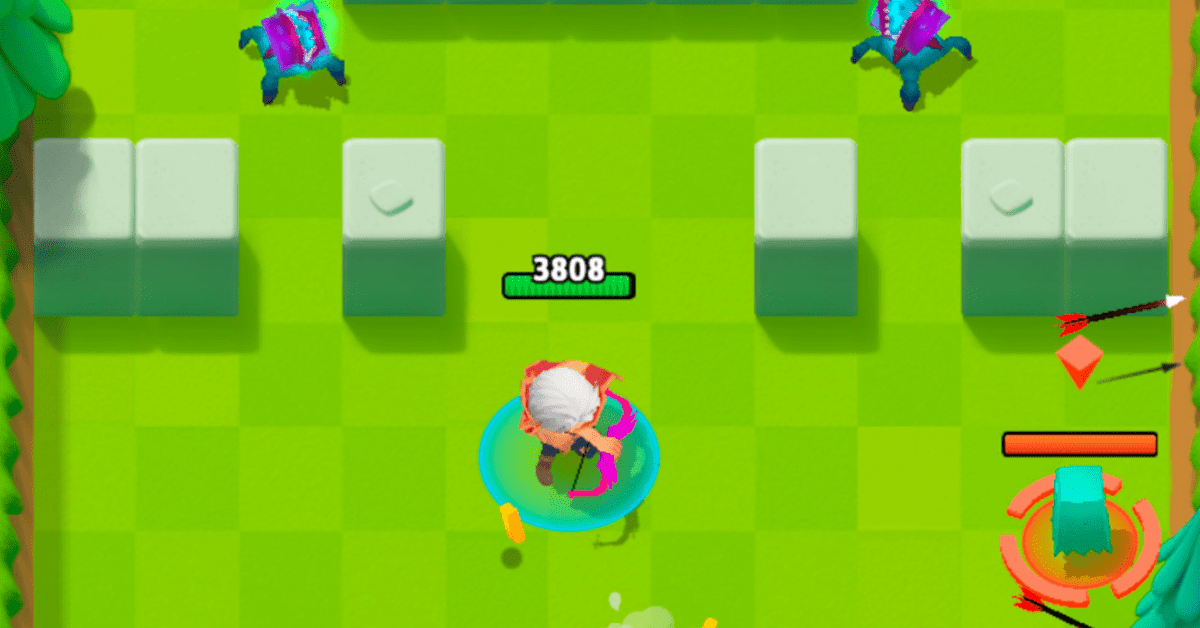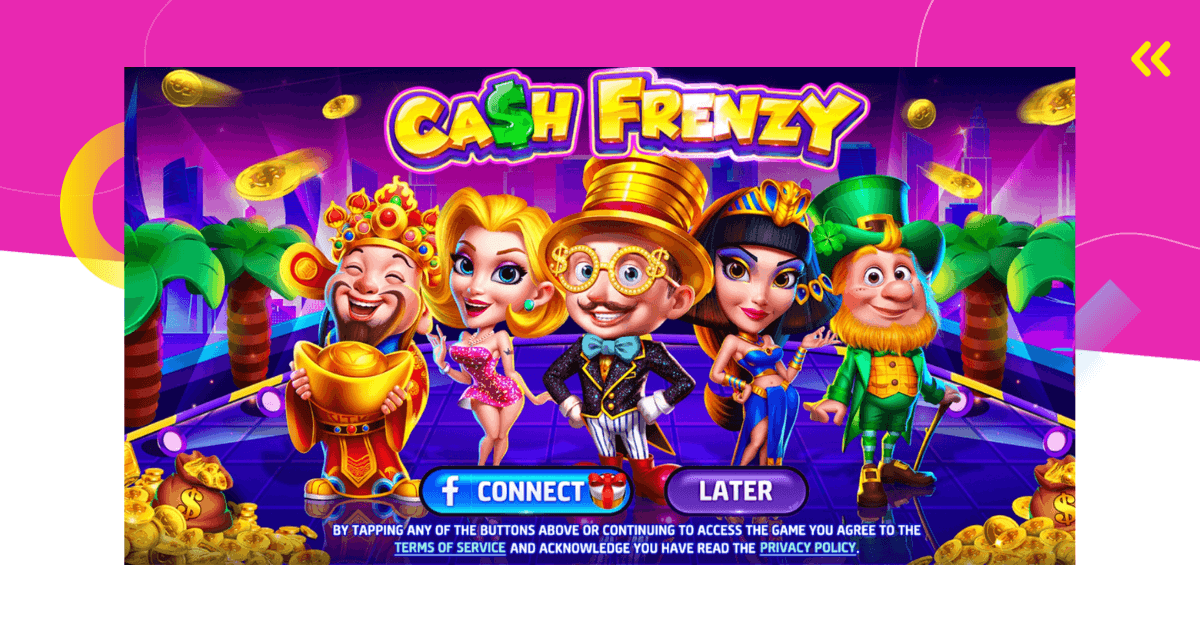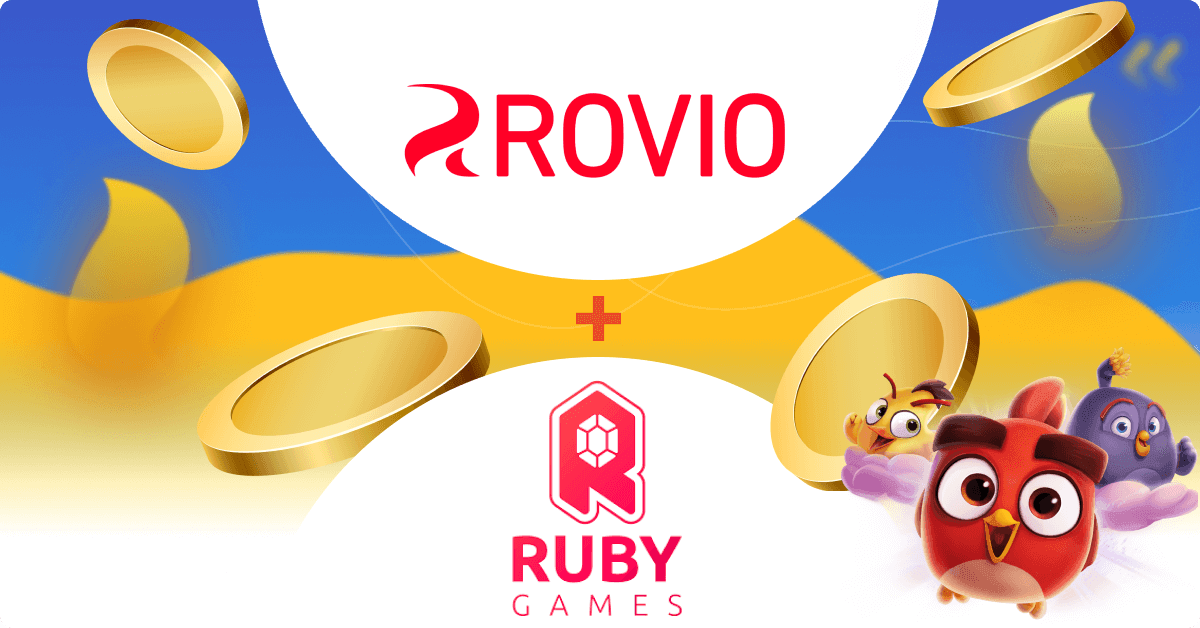Everybody knows about casual and hyper-casual games. But have you heard of hybrid-casual games?
This relatively new mobile gaming genre is taking the mobile game market by storm because of its unique fusion of different genres. Many claim hybrid-casual games have superior engagement and retention, which leads to more successful monetization.
Learn all about it in our analysis.
What Are Hybrid-Casual Games?
Hybrid-casual games is a new game genre that evolved from hyper-casual games. It’s characterized by simple hyper-casual core gameplay and mid-core game elements. This hybrid allows developers to appeal to a wider audience and boost engagement and monetization.
In order to fully understand hybrid-casual games, you must understand casual and hyper-casual games. Here’s what you need to know.

(Hyper) Casual Games
Casual games are focused on the core gameplay, e.g., match-3 puzzle. Thus, such games are simple, easy to understand, and a perfect way to pass the time or relax. Naturally, they attract a casual audience.
Hyper-casual games follow the same logic. However, they’re even more simple than casual games, especially when it comes to controls. A single tap or swipe is usually all it takes to play a hyper-casual game.
Furthermore, the monetization efforts for (hyper) casual games are also based on the core game. For example, players can obtain extra lives that allow them to continue playing or boosters that make a level easier to complete.
However, casual games would oftentimes suffer from low engagement and retention. That’s particularly true for hyper-casual games, which are known for being short-lived.
Since the core gameplay is very basic, many players lose interest over time. Additionally, because there are loads of similar games they can move to, many players aren’t as loyal to one game. That, of course, makes it difficult to monetize (hyper) casual games and results in a game that’s not profitable long-term.
Because of that, the casual games market has been evolving and maturing. Traditional (hyper) casual games are being replaced by more elaborate games, known as hybrid-casual games.
Hybrid-casual Games
Hybridization refers to mixing two or more genres to create a richer gaming experience. Most commonly, this is done by adding various meta layers and other features to the core game.
The goal is to have a game that’s accessible like a (hyper) casual game, but that drives retention and offers monetization opportunities like a mid-core game.
In other words, with hybrid-casual games, developers can reap the best of both worlds.
We often see a simple core loop with mid-core elements like competitive social features, collection systems, or a complex game economy. Because of that, in hybrid-casual games, players have long-term goals on top of the core gameplay.
Naturally, that results in hybrid-casual games having higher retention rates because players have a reason to stick around for 30 days or more. That is not the case for casual games and hyper-casual games in particular, which rarely manage to retain users after day 7.
According to Corentin Selz, publishing manager for Voodoo, they’ve seen great day-7 and day-14 retention rates for their hybrid-casual titles, as well as longer playtime. Furthermore, they’ve noticed an increase in ARPDAU, compared to their hyper-casual titles, which is a sign that hybrid-casual games monetize better.
“Coupled with advertising ARPDAU, we feel that we can comfortably reach one-year lifetime values (LTVs) of around $3, which is yet another strong indicator of the value of hybrid-casual,” Selz explains.

It’s important to note that hybrid-casual games can have a casual or a hyper-casual core. For example, you can combine casual-core gameplay like match-3 with various meta layers to create a richer game experience. You can do the same with a hyper-casual core loop, which is even simpler.
What’s great about the concept of hybrid-casual games is that developers have the freedom to mix and match many different genres and add any meta layers they like. It’s also possible to redesign an existing casual or hybrid-casual game and turn it into a hybrid-casual game by building a meta layer on top of it.
Furthermore, it’s important to note that many view hybrid-casual games as a separate genre, not a subgenre, because they have a longer player journey and the overall business model is different.
Others don’t consider it to be a genre, but rather an approach.
But whichever way you choose to look at it, it’s undeniable that hybrid-casual games are here to stay and are going to evolve further.

Hybrid-Casual Games Statistics for 2023
Here’s a short overview of the hybrid casual games market.
Data source: SensorTower
In 2022, players downloaded hybrid casual games 5.1 billion times! This is an indicator of how popular these games are.
Hybrid-casual games earned $1.4 billion in revenue in 2022, which is a significant growth compared to 2021 when the revenue was below $1 billion.
This genre is popular worldwide, not just in niche markets. Moreover, we see positive growth in downloads in almost all major markets, as you can see in the image above.

Spaced-themed hybrid-casual games are the most popular, followed by abstract, combat arena, and dungeon crawler themes.
Unlike hyper-casual games, hybrid games utilize meta layers. The most popular ones are character collection, levels, social clans, resource management, narrative stories, decoration/renovation, and social gambling.
But more on meta layers later in the article – let’s first see how hybrid games compare to hyper-casual games.
Hybrid Casual vs. Hyper Casual
If we compare hybrid and hyper-casual games, hybrid games are a clear winner in terms of US download growth on both Google Play and Apple’s App Store.
Not only that, data shows that hybrid casual games have longer sessions and playtime than hyper casual games. When comparing the two, players spend almost double the amount of time playing hybrid casual games.
There’s a clear trend of game publishers utilizing this trend that’s slowly replacing traditional hyper-casual games.
Here are some examples of successful hybrid-casual games.
What Is an Example of Hybrid-Casual Games
My two favorite examples of hybrid casual games are Archero by Habby and Project Makeover by Magic Tavern. The former has hyper-casual core gameplay, while the latter has casual core gameplay, but both have mid-core progression elements.
Here’s what you need to know about these games.

Hyper-Casual Core
One of the first hybrid-casual games with a hyper-casual core was Archero by Habby, released in 2019. This game made $8.4 million in the first month.
In its essence, it’s a hyper-casual action RPG game. In other words, the core gameplay is hyper-casual, as there are only two controls – move and shoot. However, there are additional RPG meta layers that allow players to level up the game characters and upgrade weapons.
When you play Archero, it feels like a hyper-casual game because of its simple controls. However, this game is hard to master and its RPG elements offer a layer of strategy and complexity akin to mid-core or even hardcore games. You’d be surprised how many user-made videos about Archero tips and strategies you’ll find on YouTube.
This is a great example of how hybrid-casual games can be both at the same time.

Casual Core
Project Makeover is a great example of a hybrid-casual game with a casual core. Along with a match-3 puzzle core and a fashion & makeup theme, players can engage with narrative and design meta layers.
According to Charlie Gu from Magic Tavern, “The challenge lies in how to perfectly integrate people, hairstyle, makeup, clothes, decoration, main story, background story, social and match three experience. If you are not careful, it will become a hodgepodge of four different things that casual players will not accept.”
Even though combining different elements and genres is challenging, Project Makeover proved it’s possible to hit that sweet spot.
So far, the game has earned more than $150 million in revenue and hit past 45 million downloads on iOS. (GameRefinery) On Google Play, the game has been downloaded more than 50 million times.

Empires & Puzzles is another great example of a hybrid-casual game with a casual core. So far, it bagged more than $280 million in revenue and was downloaded more than 8.5 million times. (GameRefinery) On Google Play, this game has over 50 million downloads.
The secret is in the unique mashup of match-3 puzzles and popular RPG elements. For example, besides solving puzzles, players can build their empires, farm resources, train their army, level up heroes, craft weapons, and upgrade everything.
Main Elements of a Hybrid-Casual Game
Every hybrid-casual game builds on a hyper-casual core with additional layers with the goal of boosting retention and monetizing players.
Here’s a quick overview of each element.

(Hyper) Casual Core
Hybrid-casual games most commonly have a casual or a hybrid-casual core.
A hyper-casual or arcade core game is simple so that anybody can pick it up in seconds. The controls should be so simple that you don’t even need a tutorial. However, it should be hard to master, to keep user interest.
A casual core is also pretty common. For example, a match-3 puzzle. It’s slightly more complex than a hyper-casual core, but still very easy to pick up.
Meta Layers
The meta game builds on the simple core and drives power progression, making it more interesting and engaging. The goal is to create long-term motivation with meta layers. They’re also the foundation for live services and other additional features.
Hybrid Monetization
Monetization aids players’ power progression. A combination of ads and in-app purchases drives baseline monetization, while bundles and battle passes boost conversions.
Live Ops & Social Features
Live ops and additional game features like events, social features, and updates keep the game novel, maintaining player engagement.
For example, leaderboards are an excellent social feature that allows players to track and compare other players’ success. Players can take part in various events, which offer short-term challenges. Updates have the power to invigorate the whole game and significantly impact user engagement.
In the following sections, I explain each of these hybrid-casual game elements in-depth, so make sure to keep reading.
(Hyper) Casual Core Gameplay
As we’ve established, top hybrid-casual games have a casual or hyper-casual core mechanic.
When talking about a casual core, it can be, for example, a classic match-3 puzzle or merge core. Some examples of games with a casual core are Homescapes and Project Makeover. Both have a casual match-3 puzzle core with design, decoration, and narrative meta layers.
If it’s a hyper-casual core, it’s sometimes very similar to arcade gameplay e.g., shoot ‘em up core, runner core, or hack ‘n’ slash core. A good example of hyper-casual core gameplay is the aforementioned Archero.
According to Think with Google’s report, the main pillars of hybrid-casual core gameplay are simple controls, demanding core, skill elements, and player progression.
Here’s a quick overview of each one.

Simple Controls
The controls should be so simple that players can pick them up instantly, especially if we’re talking about a hyper-casual core. The same goes for the players’ first-time user experience.
This is what makes hybrid-casual games so accessible and appealing to a wide audience. However, even though the game should be easy to learn, it should be hard to master.
Engaging Core
The core game should be straightforward. However, it should require full attention in order to be engaging. In other words, the goal is to create a balance between simplicity and skill.
Skill Elements
A hyper-casual core should also involve skill to drive engagement. According to Facebook Gaming, the feedback loop should be tied to players’ skills, and the game should have clear win/fail states and quantifiable progress.
Power Progression
Power progression is a stats-based progression system that relies on time and money spent in the game. It’s an RPG element that can take many different forms. Its purpose is to boost core gameplay. Thus, the meta game should rely on power progression.
That creates long-term motivation and engagement that keeps players coming back and increases their lifetime value.

Meta Layers in Hybrid-Casual Games
One of the most important elements of hybrid-casual games are meta layers. Without them, you’re left with an overly simple (hyper) casual game players get bored with quickly.
Why You Need to Consider Adding Meta Layers to Your Game
Before we get into popular meta layers, let’s reiterate why you should add meta layers and create a hybrid-casual game.
Stand Out from Competitors
Adding various meta layers to your game gives you the chance to differentiate it from similar games. Remember that players are always looking for something new and different.
Boost Engagement and Retention
As I already mentioned, meta layers make a game infinitely more engaging and enrich the core gameplay experience.
These extra tasks and goals are powerful motivators to keep playing. Furthermore, the meta game creates a sense of progression.
Broaden the Appeal of Your Game
Here’s the thing.
If you have a simple match-3 puzzle game, you’ll attract only casual players motivated by puzzle solving.
However, if you add a decoration meta layer, for example, the game will also attract people motivated by self-expression through customizing.
In other words, meta layers can not only add more depth to a game but also make your game appealing to a wider audience. Attracting different player cohorts makes your userbase more diverse and boosts overall engagement.
Get Additional Monetization Opportunities
When you add multiple progression vectors and create a more complex game economy with more than one game currency, you open the door for additional monetization opportunities.
Furthermore, you can monetize with both in-app ads and in-app purchases to reap the benefits of a hybrid monetization model.
Read about the most common meta layers in hybrid-casual games below.
Most Popular Meta Layers in Hybrid-Casual Games

Collection Systems
One of the most popular meta layers added to casual games are the collection systems. In such systems players can collect, for example, cards/stickers, characters/heroes, skins, resources, or even in-game achievements.
According to GameRefinery, the number of games that implement collection systems has doubled during the last few years.
Furthermore, if we look at the top-grossing 100 games, the percentage of collectibles albums’ utilization went from 20% to 70%! (GameRefinery)

Narrative Elements
A popular way of making sure players stay engaged long-term is to add a narrative and distinctive theme to your game. There’s nothing that gets players as immersed as an epic storyline, especially if they’re the hero.
What’s great about a narrative meta layer is that you can interpret it whichever way you want, as long as it fits the overall theme of your game.
A great example of a hybrid-casual game known for its riveting storylines is Lily’s Garden. This game has a casual core (match-3 puzzles) and several meta layers, one of them being the narrative meta layer. What makes it interesting are deeply engaging storylines full of romance, betrayal, drama, and scandals geared towards the female audience.
Furthermore, this game is a great example of how meta layers open up more advertising opportunities. Lily’s Garden ads are based solely on the game’s narrative layer and are wildly popular.

Design & Customization
A meta layer based on design, where players can decorate, renovate or customize is also quite popular among casual games.
It has a strong appeal to players driven by self-expression. The ability to customize or design enables them to express their identity and creativity.
A good example is Matchington Mansion by Magic Tavern. Once again, we have a casual match-3 puzzle core. Besides solving puzzles, the players are also tasked with renovating and decorating a mansion. Homescapes is another game that follows this formula.

Building Mechanics
Many popular hybrid-casual games have light construction mechanics. Oftentimes, the building mechanics are purely decorative or focus on renovation. For that reason, it ties in with the design and customization meta layer.
However, the buildings can also have a purpose and be an integral part of the game.
Family Island is an example of a casual game with a construction meta layer. The players can build a whole city in the middle of the ocean.

Upgrading Mechanics
This meta layer refers to light upgrading of game items, characters, or buildings. For example, having the option to level up a character’s skills/gear to make them stronger, which is an RPG element. Or upgrading a structure from a basic shelter to a house.
Whatever it may be, it gives players something to work towards, which has a positive effect on engagement and retention.
Progression Systems in Hybrid-Casual Games
There are two main progression systems in hybrid-casual games – skill and power progression. The former refers to core gameplay and makes the game fun. Power progression is created by meta layers and boosted by monetization, social features, and live ops. It can be anything from boosting and upgrading characters to skill trees.
The goal is to strike a balance between these two progression systems.
If power progression becomes more important than skill progression for long periods of time, you lose the fun that comes from the core gameplay. On the other hand, if power progression is not prominent enough, meta layers, monetization, social features, and live ops become insignificant.
How to Create a Power Progression?
Because most games have a main character or characters, creating power progression is quite simple.
However, you should aim to choose a core that goes well with a stat-based progression system. For example, an action core where the opponents get more powerful with every level is a great choice because it motivates players to increase their power.
A not-so-good choice would be a match-3 puzzle.
Once you choose a core, the next goal is to produce as much content as possible. This will drive player retention. Furthermore, the difficulty curve needs to be smooth, which is easy to do if you have enough content.
In order to keep up with the difficulty curve, players need to become more powerful, as their skills can only take them so far. Finally, high player LTV is achieved when meta layers allow players to gain power beyond skill limits.

It’s also important to note that progression systems in hybrid-casual games shouldn’t be as deep as in a role-playing game. Above, you can see an example of typical RPG progression systems, and where the sweet spot is for hybrid-casual.

Furthermore, what makes hybrid-casual games unique is that even if they have elements of other genres like RPG, players’ decision-making is simplified. For example, in core games, players spend a lot of time thinking about and strategizing which progression vector to upgrade. In hybrid-casual games, most of the work is done for them in order to bring players back to the core gameplay as quickly as possible.

Keeping the Game Fresh with Additional Features
Along with core gameplay and meta layers, hybrid-casual games benefit from additional features that cement the overall retention and engagement, while boosting monetization.
One of the most important ones is social features. Traditionally reserved for mid-core games, social features like guild systems, co-ops, and live events can now be found in hybrid-casual games as well.
The desire to connect, not just in games but in real life, has significantly increased over the last couple of years. For that reason, creating a hybrid game with strong social features is imperative.
However, these mechanics should be introduced gradually, since we’re talking about a casual audience.
Live events, especially recurring ones, are another way to keep players glued to their screens. The same goes with special playing modes – this is another great way to make your game stickier.
Finally, another traditionally mid-core feature that’s a great addition to hybrid-casual games is a season pass system, which is basically a battle pass.
Popular games like Gardenscapes and Clockmaker take advantage of this feature, as well as 30% of top match-3 games, according to GameRefinery.
A season pass creates long-term retention and makes players feel accomplished. Another great thing about season passes is that they don’t affect core gameplay, which is perfect for hybrid-casual games.

How to Monetize Hybrid-Casual Games?
Traditionally, most casual games and especially hyper-casual games have usually been monetized with in-app ads. Sessions were short, as well as game lifespans so the goal was to monetize as many players as quickly as possible.
However, adding meta layers to casual games has created more opportunities for monetization with in-app purchases.
Incorporating both models tends to be the most beneficial. Integrating both in-app ads and in-app purchases is called a hybrid monetization model.
According to Think with Google, “Among hybrid-genre gamers, 33% watch rewarded ads to get more lives and 28% make in-app purchases to get access to exclusive items.”
While ad-based monetization is quite simple for a hybrid-casual game, in-app purchases are trickier to get right.
So how do you successfully add an IAP model to your game and get players to spend?
I’ll start by saying that there’s no magic formula for designing an IAP model for a hybrid-casual game, or any game for that matter.
Different cores, meta layers, and audiences require different approaches.
With that in mind, there are some general tips that might help you.

Create a Balanced In-Game Economy
Many games have different currencies, for example, coins or gems, which are the basis of a game economy. This is particularly important for games that have an IAP monetization model.
The more currencies a game has, the more complex the game economy is.
Furthermore, not all currencies have the same value. For example, hard currency is the game’s most valuable currency and is most commonly used for monetization as its source is limited. On the other hand, soft currency is easily obtainable and thus not as valuable. Some games also have medium, premium, energy, and social currencies.

Taps and Sinks
In order to learn how to create a balanced game economy, you first need to understand two essential concepts – taps and sinks.
Put simply, a tap is where game resources come from, whether it’s from an in-app purchase or a game mechanic. For example, a currency like coins.
A sink is where players spend those resources. For example, a player spending currency on gear.
Naturally, if the tap is releasing too many resources too fast, the sink becomes flooded. In other words, if there are too many resources, they become worthless to players.
Similarly, if not enough resources are coming from the tap, players will become disinterested and have no motivation to engage with the resources.
Thus, the key to a balanced game economy is in the pinch point. This is the point when players understand the value of resources, but they’re scarce, creating a high demand and making players seek it out. In the case of in-app purchases, players are motivated to buy that resource with real money.

Motivate Players to Spend with Progression Vectors
Along with a balanced game economy, progression vectors are also essential for in-app purchases.
Various progression vectors are the main reason users play a mobile game, which increases retention and can also be a motivation to spend on in-app purchases.
The three main progression vectors are levels, power, and battle passes.
When players fail to complete a level, they may be inclined to pay to continue a failed level or get a booster that will help them complete it.
Furthermore, more power equals more winning. That’s why a power progression can also make players spend on IAP.
Finally, battle passes provide users with additional content and reward them for completing various tasks. Those who purchase a subscription get better rewards, which is a strong incentive.

Understand Why Players Spend
Another essential thing to understand is why players spend?
According to the Department of Play, there are four main categories players spend on, which helps us understand the motivation behind each one.
The so-called Four C’s are Cosmetics, Competitive Advantage, Convenience, and Content.
Here’s a short explanation of each one.
Cosmetics
Cosmetic purchases include items like skins for characters or weapons, accessories, and avatars. Basically, anything that allows players to customize or change the appearance of an item or character.
Just like in real life, players want to express their identity, stand out, or signal their status, which is what makes these types of purchases very desirable.
Competitive Advantage
Many players are willing to pay for various boosts and upgrades that give them a competitive advantage and allow them to win more.
There’s also loss aversion, where players are more likely to pay for avoiding a loss than to win.
Convenience
In many (hybrid) casual games, players need to wait in order to make progress in the game. For example, waiting until a building is completed or until their energy is refilled.
That can be very frustrating, hence many players are willing to pay to skip timers or for life refills.
Content
Additional content makes all games more entertaining, whether it’s new characters, maps, or levels. In free-to-play games, making users pay for more content is rare, particularly for (hybrid) casual games. It makes more sense to give it for free to increase players’ retention and engagement and thus create more opportunities for monetization.
Benefits of Hybrid-Casual Games
If you’re still not convinced hybrid-casual games are awesome, here are some of the revenue-boosting benefits of this genre.
Stand Out
As you already know, the casual market is very competitive. There are thousands of casual and hyper-casual games in the app stores, all of them fighting for the same group of players. Since these games have similar mechanics, players usually go with established publishers. That makes it almost impossible to get noticed, especially if you’re not among the top casual publishers.
If you create a hybrid-casual game, on the other hand, you instantly have a USP and features that can help you stand out. Many casual players are looking for something different and new, so make sure to take advantage of that.
Additionally, that makes both user acquisition and app store optimization a bit easier, as you can base ad creatives, the app promo video, and other content on unique features and meta layers.
Reach More Players
Because hybrid-casual games contain various meta layers, mechanics, and features from other genres, that allows you to broaden your target audience. Naturally, that can boost your user acquisition efforts and help you draw in more users.
However, avoid making your target audience too wide. The charm of hybrid-casual games is that you get to target higher-quality users than you would with hyper-casual games due to their additional, i.e., meta layer. If a meta layer is a town-building strategy, chances are you’ll get better results from targeting primarily male audiences. On the other hand, the same can be said for games with a design/dress-up meta layer and targeting the female audience.
Increase in Engagement
Here’s the thing.
Traditional hyper-casual and casual games can get pretty boring pretty quickly. Even though they can be highly addictive, their simple nature is often not enough to keep players interested.
Meta layers in hybrid-casual games keep players engaged for extended periods of time, as they have something to work on besides core gameplay. For example, in addition to solving match-3 puzzles, they’re also renovating/decorating a house or solving a murder mystery.
Better Retention
Finally, hybrid-casual games have better retention, as players have many reasons to come back to the game – different meta layers, additional features, and multiple progression vectors.
Good retention, in turn, provides developers with more options to monetize their players and increase revenues.
Hybrid-Casual Games: Final Thoughts
We’ve come to the end of our analysis of hybrid-casual games. Hopefully, it gave you some insight into this exciting genre.
We expect more and more games to follow the hybrid formula, as these types of games are superior when it comes to engagement and retention.







Comments